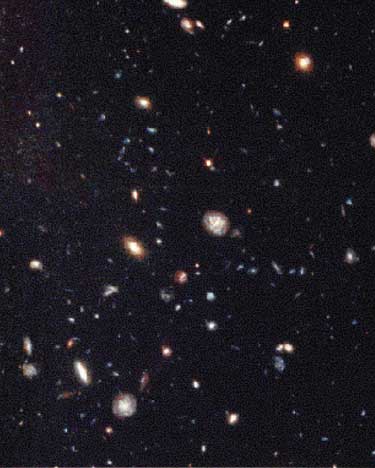 |
A Hubble Space Telescope  view down a corridor of space 12 billion light-years long reveals spirals like our own Milky Way dominating the galactic cast of thousands--all within a patch of sky no broader than a grain of sand held at arm's length. Elliptical galaxies with older stars appear as reddish blobs, and peculiar-shaped galaxies may mark the sites of intergalactic collisions. This image is of the sky in the Southern Hemisphere. view down a corridor of space 12 billion light-years long reveals spirals like our own Milky Way dominating the galactic cast of thousands--all within a patch of sky no broader than a grain of sand held at arm's length. Elliptical galaxies with older stars appear as reddish blobs, and peculiar-shaped galaxies may mark the sites of intergalactic collisions. This image is of the sky in the Southern Hemisphere. |
that the Apollo astronauts did not venture far from home at all--and that our planet is the human race's only home for the foreseeable future.
Another stirring image came from the Hubble Space Telescope  , which stared at a single tiny patch of sky for days on end. The telescope actually captured two such "deep-field" images, one in Northern Hemisphere skies and one in the Southern Hemisphere. They each revealed thousands of galaxies sparkling like gems in an infinite jewel box. Some were relatively close to our Milky Way, while others were near the edge of the visible universe. All of the galaxies were seen within patches of the sky the size of a grain of sand held at arm's length. These pictures were humbling and exhilarating, for they were our most detailed glimpses into the depths of the cosmos. , which stared at a single tiny patch of sky for days on end. The telescope actually captured two such "deep-field" images, one in Northern Hemisphere skies and one in the Southern Hemisphere. They each revealed thousands of galaxies sparkling like gems in an infinite jewel box. Some were relatively close to our Milky Way, while others were near the edge of the visible universe. All of the galaxies were seen within patches of the sky the size of a grain of sand held at arm's length. These pictures were humbling and exhilarating, for they were our most detailed glimpses into the depths of the cosmos.
We AreSTARDUST
When we see pictures of those distant glowing islands of stars, it's natural to wonder about the origins of matter. Where did the ingredients of galaxies come from--and how did they ultimately give rise to planets and living things? Astrophysics has provided the most successful explanation so far of the creation of the elements, a process called nucleosynthesis  . .
Two significant phases of nucleosynthesis  mark the history of the universe. The first occurred just after the Big Bang, the universe's fiery origin. At first the temperature of the universe was too hot for any matter to exist separate from energy. But as the temperature fell below a trillion degrees Celsius, protons mark the history of the universe. The first occurred just after the Big Bang, the universe's fiery origin. At first the temperature of the universe was too hot for any matter to exist separate from energy. But as the temperature fell below a trillion degrees Celsius, protons  and neutrons and neutrons  began to "freeze out" from the superhot, superdense primordial soup began to "freeze out" from the superhot, superdense primordial soup  . By the time the temperature dropped to a mere 10 billion degrees, the universe had created all of its protons . By the time the temperature dropped to a mere 10 billion degrees, the universe had created all of its protons  and neutrons and neutrons  , and electrons , and electrons  were beginning to freeze out as well. The cosmos was just one second old. were beginning to freeze out as well. The cosmos was just one second old.
Over the next few minutes--three at least, 10 at most--all the neutrons  either decayed into pairs of protons either decayed into pairs of protons  and electrons and electrons  or were captured by other protons or were captured by other protons  to form helium to form helium  , deuterium , deuterium  (a heavy form of hydrogen), and tiny traces of slightly heavier (continued) (a heavy form of hydrogen), and tiny traces of slightly heavier (continued) | 
